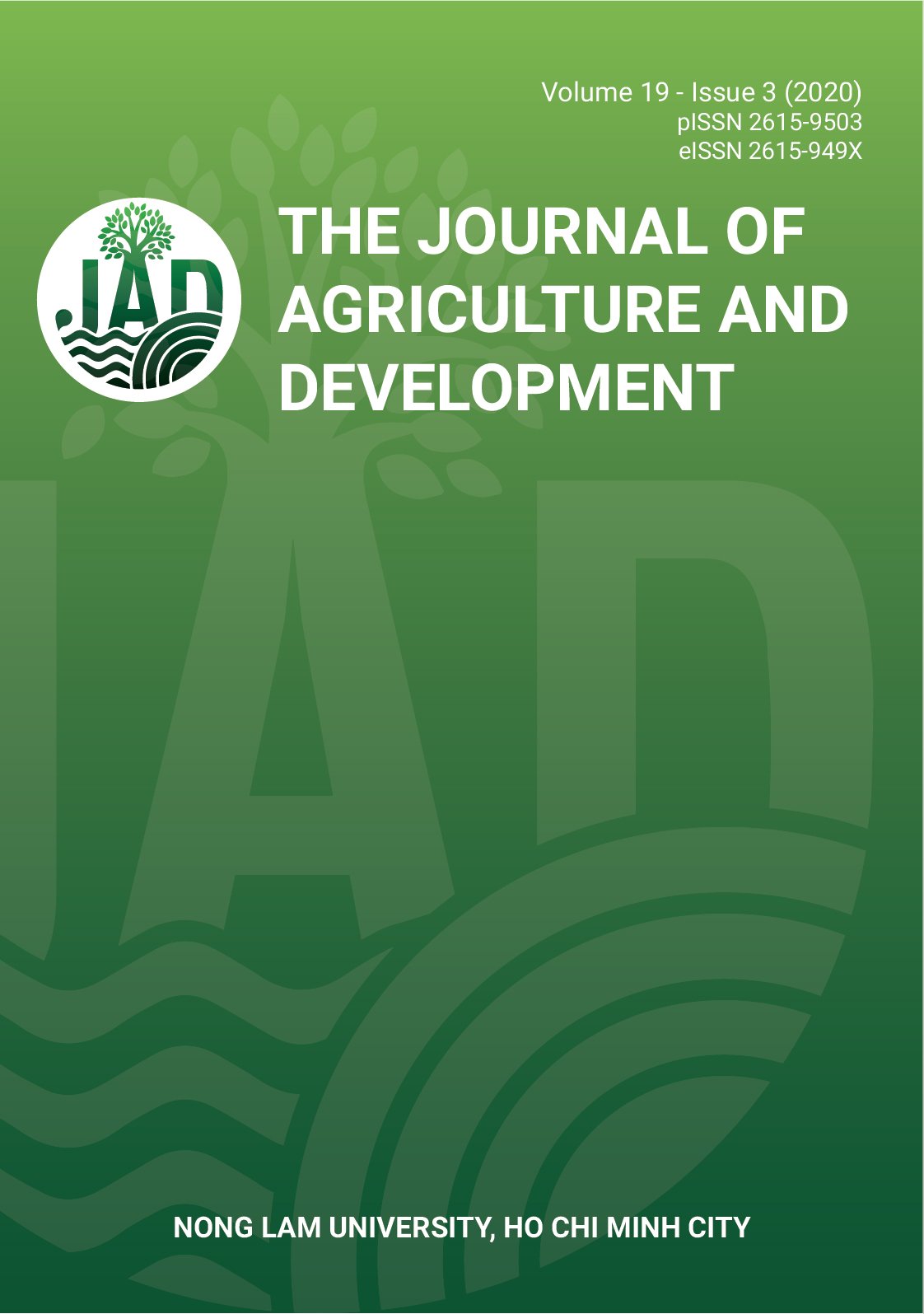Infection status of Mycoplasma hyopneumoniae in experimental pigs at a commercial farm
Main Article Content
Abstract
The objective of this study was to investigate the profiles of Mycoplasma hyopneumoniae (MH) infection at different ages of pig in a sow – finishing herd using serological and molecular methods. A total of 30 study piglets were born from non-vaccinated sows with MH. They were injected one-dose of inactivated MH vaccine at the 10th week. MH infection status was evaluated by using ELISA to detect MH antibodies from blood samples, and PCR to detect MH DNA in nasal swabs or oral fluid samples every other weeks from newborn to slaughter time. The results of this study showed that PCR positive proportions were low at 1st-2nd week (7-13%), then increased significantly during 5th -7th week (73-79%), and reduced at 8th week (33%); finally became negative after 13th week of age. This pattern corresponds to the one of antibody level. In particular, the level of maternal antibodies against MH was very high due to maternal immunity, then decreased gradually to negative at 7-8 weeks of age, and finally increased gradually from 13 weeks of age to all positive at 25 weeks of age. In conclusion, the result showed that in this herd, MH might invade pigs by the time of 5-7 weeks of age after maternal immunity disappears, and humoral response can overcome the infection at week 13. This should be noted to have appropriate strategies to control MH at the farm.
Article Details
References
Abhijit, K. B., Lee, H. Y., Jeong, H. W., Truong, L. Q., Joo, H. G., & Hahn, T. W. (2012). An improved multiplex PCR for diagnosis and differentiation of Mycoplasma hyopneumoniae and Mycoplasma hyorhinis. Korean Journal of Veterinary Research 52(1), 39-43. https://doi.org/10.14405/kjvr.2012.52.1.039
Arsenakis, I., Michiels, A., del Pozo Sacrist ́an, R., Boyen, F., Haesebrouck, F., & Maes, D. (2017). Mycoplasma hyopneumoniae vaccination at or shortly before weaning under field conditions: a randomised efficacy trial. Veterinary Record 181(1), 19. https://doi.org/10.1136/vr.104075
Bandrick, M., Pieters, M., Pijoan, C., & Molitor, T. W. (2008). Passive transfer of maternal Mycoplasma hyopneumoniae -specific cellular immunity to piglets. Clinical and vaccine immunology 15, 540-543. https://doi.org/10.1128/CVI.00466-07
Djordjevic, S. P., Eamens, G. J., Romalis, L. F., Nicholls, P. J., Taylor, V., & Chin, J. (1997). Serum and mucosal antibody responses and protection in pigs vaccinated against Mycoplasma hyopneumoniae with vaccines containing a denatured membrane antigen pool and adjuvant. Australian Veterinary Journal 75(7), 504-511. https://doi.org/10.1111/j.1751-0813.1997.tb14383.x
Haden, D. C., Painter, T., Fangman, T., & Holtkamp, D. (2012). Assessing production parameters and economic impact of swine influenza, PRRS and Mycoplasma hyopneumoniae on finishing pigs in a large production system. Proceedings of American Association of Swine Veterinarians Annual (75-76). Denver, Colorado, America.
Leon, E. A., Madec, F., Taylor, N. M., & Kobisch, M. (2001). Seroepidemiology of Mycoplasma hyopneumoniae in pigs from farrow-to-finish farms. Veterinary Microbiology 78(4), 331-341. https://doi.org/10.1016/S0378-1135(00)00303-5
Maes, D., Verdonck, M., Deluyker, H., & de Kruif, A. (1996). Enzootic pneumonia in pigs. Veterinary Quarterly 18(3), 104-109. https://doi.org/10.1080/01652176.1996.9694628
Meyns, T., Maes, D., Dewulf, J., Vicca, J., Haesebrouck, F., & de Kruif, A. (2004). Quantification of the spread of Mycoplasma hyopneumoniae in nursery pigs using transmission experiments. Preventative Vetererinary Medicine 66(1-4), 265-275. https://doi.org/10.1016/j.prevetmed.2004.10.001
Morrison, R. B., Hilley, H. D., & Leman, A. D. (1985). Comparison of methods for assessing the prevalence and extent of pneumonia in market weight swine. Canadian Veterinary Journal 26(12), 381-384.
Sheldrake, R. F., Gardner, I. A., Saunders, M. M., & Romalis, L. F. (1990). Serum antibody response to Mycoplasma hyopneumoniae measured by enzyme-linked immunosorbent assay after experimental and natural infection of pigs. Australian Veterinary Journal 67(2), 39-42. https://doi.org/10.1111/j.1751-0813.1990.tb07691.x
Sibila, M., Nofrarias, M., Lopez-Soria, S., Segales, J., Valero, O., Espinal, A., & Calsamiglia, M. (2007). Chronological study of Mycoplasma hyopneumoniae infection, seroconversion and associated lung lesions in vaccinated and non-vaccinated pigs. Veterinary Microbiology 122(1-2), 97-107. https://doi.org/10.1016/j.vetmic.2007.01.010
Thacker E., & Minion, F. (2012). Mycoplasmosis. In Zimmerman, J. J., Karriker, L. A., Ramirez, A., Schwartz, K. J., & Stevenson, W. G. (Eds.). Diseases of Swine (10th ed., 779–798). New Jersey, USA: Wiley- Blackwell.
Thacker, E. L., Thacker, B. J., Kuhn, M., Hawkins, P. A., & Waters, W. R. (2000). Evaluation of local and systemic immune responses induced by intramuscular injection of a Mycoplasma hyopneumoniae bacterin to pigs. American Journal of Veterinary Research 61, 1384-1389. https://doi.org/10.2460/ajvr.2000.61.1384
Zhang, Q., Young, T. F., & Ross, R. F. (1995). Identification and characterisation of a Mycoplasma hyopneumoniae adhesin. lnfection lmmunology 63, 1013-1019. https://doi.org/10.1128/iai.63.3.1013-1019.1995








